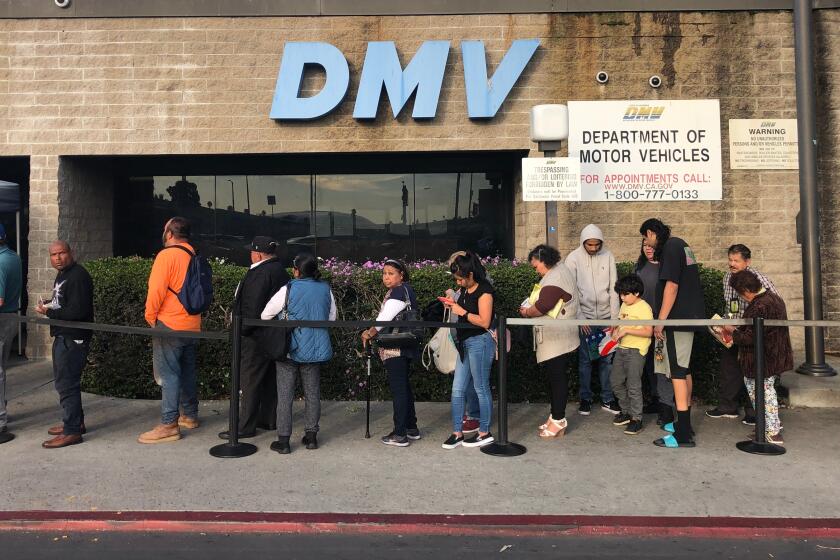Ready, set, walk out: Schools prepare for expected student protests on Wednesday
- Share via
As a 16-year-old in high school and a student of history, Axel Ortega faces a tough choice on Wednesday morning: Does he walk out of class at Garfield to take a stand or stay put? And if he walks out, does he leave his East Los Angeles campus?
Axel’s principal and other administrators also have been pondering what choices Axel and other students will make and how to respond.
Wednesday is the one-month anniversary of the mass shooting at Marjory Stoneman Douglas High School in Parkland, Fla. Student activists across America have declared it a national day of action to raise awareness about the effects of gun violence and push for lawmakers to take action to reduce it. Many different activities have been planned, and thousands of students from coast to coast are expected to walk out of classes for 17 minutes, in honor of the 17 killed in Parkland.
L.A. Unified officials find themselves in an ironic place. For about a month they’ve celebrated the 50th anniversary of Eastside walkouts in which students, mostly Mexican descent, defied teachers, administrators and police. Those walkouts changed things for the better, they’ve said.
At the same time, officials said they would prefer students stay in their classes and do other things now, such as carrying out “17 acts of kindness.”
Axel took part this month in a district-sponsored reenactment of a school board meeting from the Eastside walkouts era. Those walkouts “took a lot of courage,” he said. “I know many students were beaten up by police and the teachers didn’t allow them to go and some didn’t have the support of their parents.”
In the run-up to Wednesday, many campus administrators offered compromises — allowing students to leave class for in-school events paying homage to the 17 who lost their lives in Parkland.
At the Carson High campus quad, students will hold a 17-minute sit-in. Some will speak about ways to deter violence.
At Francis Polytechnic High in Sun Valley, students will link arms on the football field during a one-hour assembly with the title #NeverAgain.
Interim L.A. schools Supt. Vivian Ekchian will join Eagle Rock High students for a silent remembrance before 17 empty chairs.
School police will not physically block students from walking off campus but will encourage them to stay put, said L.A. Unified School Police Chief Steve Zipperman.
In previous walkouts, school staff members — and school police — often have joined students to keep them together and supervised. Arrests are rare, though officials don’t rule out the possibility that some students could face discipline on Wednesday.
The #Enough National School Walkout has been organized by the youth arm of Women’s March, the nonprofit that planned mega-demonstrations in January 2017 and 2018. Organizers say that more than 2,800 walkouts are scheduled nationwide — as clocks strike 10 a.m. in each time zone.
The students in Parkland are organizing a separate event, March for Our Lives, on March 24 in Washington, D.C., with hundreds of affiliated actions planned around the country.
In 1968, the divide between district administrators and students was large. Today’s L.A. Unified officials express much in common with the students. On Tuesday, the school board passed a resolution calling for bans on assault weapons, universal background checks for gun purchasers and other gun-control measures. And a delegation of district officials is scheduled to be in Washington on Wednesday to lobby for stricter gun control.
But students are planning wildcat events to push against some district policies.
Axel wants to end the practice of randomly searching students and to remove police from campus — or at least redefine officers’ roles.
“Honestly, I feel intimidated about them being there,” he said. “They should get to know us instead of stopping us for no reason. They could be nearby, but I don’t know why they’ve got to be at school. School is a safe place. I don’t think we need them inside.”
School police insist that they see themselves as mentors and unofficial counselors.
Many student organizers across the country have shared views similar to Axel’s. They hope to use the heightened public attention to voice them.
Talk of bringing in more police or arming teachers “just sounds like making our schools into prisons, which they already are,” said Walle Telusnord, a senior at Miami Edison High School in Miami.
For students in South L.A. and on the Eastside, violence isn’t so much the rare, terrifying appearance of a gunman, but an everyday trauma, said Jennifer Maldonado, a community organizer who works with students through the East L.A. group InnerCity Struggle.
“They know about gun violence because it happens in our communities, either between each other or from police brutality,” Maldonado said.
Los Angeles has a long history of student walkouts, stretching back to the 1968 Eastside “blowouts,” when thousands of students, most of Mexican descent, staged protests for more than a week, demanding better learning conditions. In 2006, close to 40,000 students across Southern California walked out to protest proposed immigration legislation. In November 2016, thousands of high school students marched to City Hall and other landmarks to protest the outcome of the presidential election.
“Students are engaged and ... they’re willing to stand up for their fellow students in powerful and compelling ways,” said Victor Leung, deputy litigation director at ACLU of Southern California.
In Southern California, many walkouts are expected in schools — including those in Corona del Mar and Glendale — not often associated with activism.
South High in Torrance alerted parents in a letter of two separate, simultaneous demonstrations: one promoting gun-control measures; the other opposing them.
“Planned speeches are designed to be respectful and appropriate,” wrote Principal Scott McDowell.
Twitter: @Sonali_Kohli
UPDATES:
8:50 p.m.: This article was updated to include an additional reason for the walkouts.
This article was originally published at 7:30 p.m.












